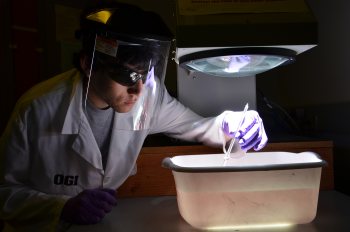You are here
Week 3: It's summer, but it's only sunny on the inside
Somehow, despite being summer, it was still overcast and rainy here in Portland for most of the week. Inside CMOP though, it's been bright and sunny, because we're running the photodegrataion portion of our experiment. These experiments are used to determine how the PAHs in oil degrade over time when exposed to sunlight. Some studies have shown upwards of 30% of an oil slick to be broken down by natural sunlight.
 Since we don't have the luxury here of natural sunlight, we rely on an instrument to do that job for us. A solar simulator is an instrument which emits full-spectrum light at high intensity, to mimic the energy output of the sun. Samples of our seawater with PAHs in them were placed under the solar simulator, stirred frequently so that the solution was evenly degraded, and kept at a constant 15 C. This is a very time-intensive experiment, because one must keep an eye on the system at all times to ensure the proper operating temperature and keep the solutions stirred. Because the light is so bright and the UV wavelengths can cause skin and eye damage, we have to wear protective gear in the solar simulation room, such as some very cool sunglasses and a stylish lab coat.
Since we don't have the luxury here of natural sunlight, we rely on an instrument to do that job for us. A solar simulator is an instrument which emits full-spectrum light at high intensity, to mimic the energy output of the sun. Samples of our seawater with PAHs in them were placed under the solar simulator, stirred frequently so that the solution was evenly degraded, and kept at a constant 15 C. This is a very time-intensive experiment, because one must keep an eye on the system at all times to ensure the proper operating temperature and keep the solutions stirred. Because the light is so bright and the UV wavelengths can cause skin and eye damage, we have to wear protective gear in the solar simulation room, such as some very cool sunglasses and a stylish lab coat.
At intervals throughout the day we ran the experiment, we pulled out two vials of the PAH samples to run through the fluoromax. Over the day, we were hoping to see changes in the intensity of the peaks. We've just started to analyze the data, but initial results are promising: the peaks associated with individual PAHs were decreasing as the experiment progressed.



